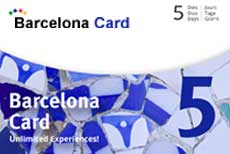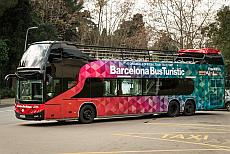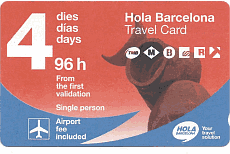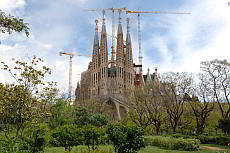Fundació Joan Miró
The museum with Miró's works in Barcelona
When traveling to Barcelona, you will inevitably come across art works by the artist Joan Miró: when you arrive at the airport, you will be greeted by a huge mosaic of Miró and the city's most representative bank, la Caixa, has a star created by the artist in the logo.
Recommendations for the Miró-Museum
- Free admission with the Articket and the Barcelona Card
- Get to the Miró-Museum with the Bus Turístic
Close to Plaça Espanya at Parc de Joan Miró, behind the department store Las Arenas, Joan Miró's "Dona i Ocell" (woman and bird), a colourful tribute to the fusion of man and woman, is located. If you're getting to Barcelona via cruise ship over the harbour: even here you are welcomed by Miró's round mosaic face at the Ramblas.
It is worth it, to dedicate your time to Miró's works at the museum Fundació Joan Miró. An opportunity arises to walk from Plaça Espanya to the Miró Museum. Stroll past the MNAC, the Catalonian national museum, through the small Jardí de les Escultures, which is leading you straight to the Fundació.
Interesting Facts for Visiting Fundació Joan Miró
The Miró Museum and the Fundació Joan Miró
The foundation Fundació Joan Miró was initiated by the artist Joan Miró himself and the same year, the museum was opened on June 10th in 1975. The artist relinquished the majority of his works to the foundation. Other works are presents from his wife Pilar Juncosa, Joan Prats und Kazumasa Katsutas. Well known skulptures such as the "Couple d’Amoureux aux Jeux de Fleur d’Amandier" (1975) and a large, lavishly designed wall hanging, made particularly for the foundation, are among these works.
The museum owns over 10.000 paintings, drawings, sculputes, stage designs and carpets from Joan Miró - the earliest drawings are from 1901. On the roof top terrace you can admire Miró's colourful sculpures together with a wonderful view of Barcelona. The Miró museum enfolds by far the largest collection of Joan Miró's works today.
Miró wanted to create an international, interdisciplinary centre, which makes art publicly available. Until today the foundation organizes alternating contemporary exhibitions from the 20th and 21st century, as well as academic research projects and cultural events. Among others we recommend the "Nits de música" (nights of music) with numerous offers of classical music, where international artists perform each Thursday. The centre received the European Museum of the Year Award in 1977.
The Museum Building
The building was created by Josep Lluís Sert, Miró's good friend and Le Corbusier's student. You can recognize the close friendship and the cooperation of them by the alternation of exhibit and architecture: both tended to harmonic forms and playing with light, space and colours; besides that they combined their love to nature and Catalonia, which explains the architactural distinctiveness of the inner courtyard in the middle of the building, which all the rooms are centrifugically arranged to. You can find this typical Catalonian, from Roman times originating so called "Impluvium" in numerous Catalonian monasteries and palaces.
During Franco's dictatorship, Josep Lluís Sert was the head of School of Design at Harvard University in the U.S. and was thus the first internationally renowned Spanish architect. In 1929 he founded the GATPAC (Grup d'Arquitectes i Tècnics per the Progrés de l'Architecture Contemporània), to release a pulse towards the modernisation and development of the Spanish architecture. He was especially influenced from the well known architects Wright, Gropius, Mies Van Der Rohe and his teacher Le Corbusier, which is reflected in his rational and pragmatic style.
The clear and cubistic shapes all in white make the museum building look light and flowing and make the rooms look larger. The offset arrangement of the inner rooms, interfused by bright patios and terraces create dynamic, transparency and a lot of natural light in the inside of the building. For Josep Lluís Sert the core elements were flexibility and movement, without losing spacial continuity. As a result, the visitors are given the opportunity to experience the artwork in different ways, depending on which room they are approaching the objects from.
The building was expanded in 1986 and 2000 and received the „Twenty-Five Year Award“ of the American Institute of Architects in 2002.
From the terrace of the museum you have a wonderful view over the buildings of Barcelona. After the exhibition you can anjoy a break in the museum café in between Miró's sculptures and afterwards visit the musum library, which holds the artist's personal book collection.
Book tickets for the Miró Museum here
- Miró Museum: tickets for admission here
- Articket: admission to 6 most famous museums, valid for one year
- Barcelona Card: many discounts and free admissions
- Bus Turístic: hop-off directly in front of the Miró Museum
Important information
Surroundings
Find Hotels nearby
Address
Avinguda Miramar, 71-75, Parc de Montjuïc
Phone: +34 934 439 470
www.fmirobcn.org/en/
Arrival
Metro: Paral·lel (L2, L3), dann mit der Funicular de Montjuïc (Standseilbahn)
Bus Turístic: Fundació Joan Miró
Parking nearby
Opening times
Tue. - Sat.: 10:00 - 20:00
Sun.: 10:00 - 18:00
Access to the Foundation 30 minutes before closing
Closed on Mondays, except 2 Jan., 10 and 24 April, 1 May, 5 June, 11 and 25 September 2023.
Admission
Regular ticket: €14.00
Students, seniors 65+: €7.00
Children up to 14 years: free
Free admission with the Barcelona Card and the Articket Barcelona.
Tips for the visit of the Fundació Joan Miró
The easiest way to get to the museum by Bus Turístic (red line). It stops in front of the Fundació Joan Miró.
For the museum you should plan about 1.5 hours.
Book your accommodation in Barcelona here! All categories.
1-5*-hotel rooms, apartments, hostels.




